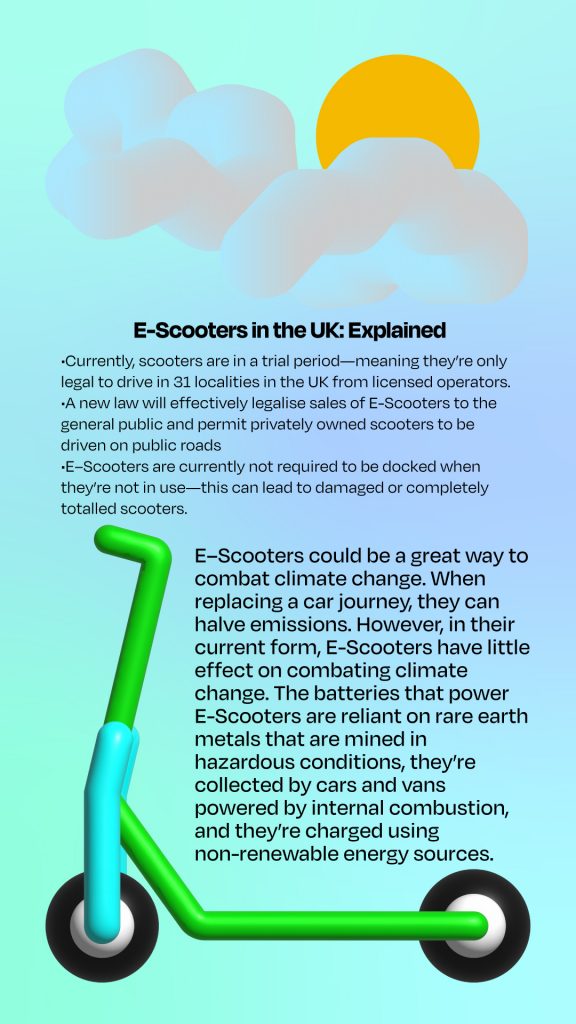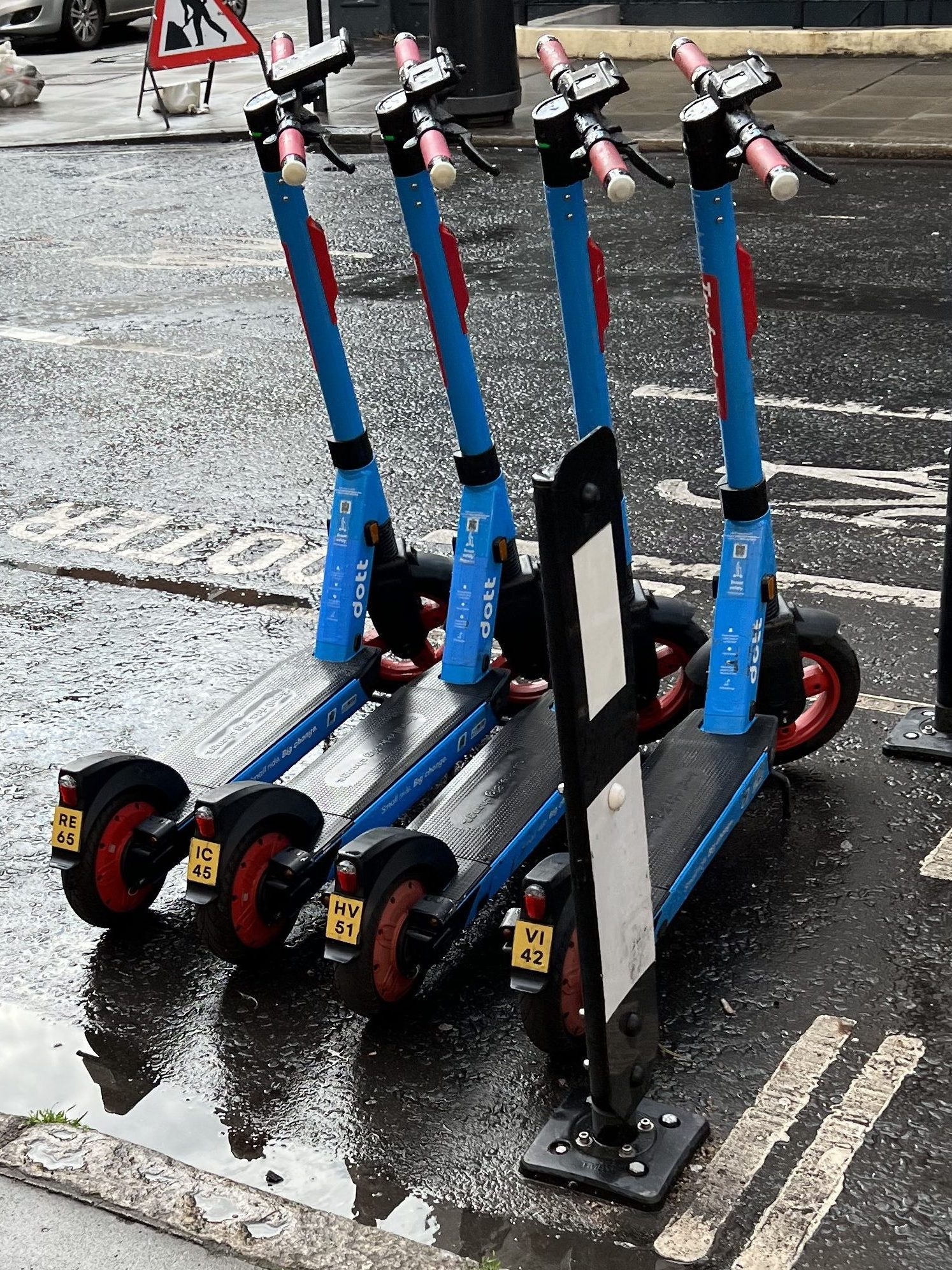Members of Parliament are planning on introducing new regulations for E-Scooters in the UK.
E-Scooters, stand up scooters with an electric motor, are an increasingly popular solution for last-mile and micro-mobility solutions. E-Scooters work by drawing power out of a sizeable lithium-ion battery pack. Most have a range of around 20 miles—or about the distance from central London to Slough.
Members of Parliament are considering making it legal to ride e-scooters on public roads and public lands across the UK.

Currently, scooters are in a trial period—meaning they’re only legal to operate in 31 localities in the UK. They have some regulations both for users and operators.
Users currently need to stay on cycleways and roads, and operators must limit scooters to 15.5 mph, 500-watt motors, and must provide road insurance to their users.
Unlike other online services targeted at young people, scooters are generally accessed via subscriptions and pay-as-you-go models. Scooters can cost hundreds, sometimes thousands of pounds—the subscription model effectively erases those barriers if you need the scooter for a short amount of time, or don’t plan on commuting on it every day.
The new law will effectively legalise sales of E-Scooters to the general public and permit privately owned scooters to be driven on public roads. Though sales are currently illegal, it is clear that this rule is hard to enforce—there are many large scooters, electric unicycles, electrically powered skateboards, etc. that roam the streets.
In theory, E-Scooters should be a faultless way to quickly connect underserved and disconnected areas of a city and public transit network with little public investment, while not expelling any CO2 along their journeys—a true victory in the battle against climate change.
However, further analysis of E-Scooters presents many negatives to E-Scooters, not only for the environment but also for public safety.
The harsh reality of E-Scooters
As summarized perfectly in a 2019 BBC article, E-Scooters present a great variety of issues that ultimately diminish their environmental credibility.
The glaring issue with electric transportation in general (minus electric trains, which are powered as they go along their route via a wire or third rail), is the reliance on rare earth elements which need to be mined, such as lithium, cobalt, and nickel. An MIT study found that “Producing lithium-ion batteries for electric vehicles is more material-intensive than producing traditional combustion engines.”
Mines themselves are often another issue, because, in addition to producing tons of CO2 from mining equipment and production & distribution of mined materials, working conditions for miners are often deadly, dangerous, and provide low pay even in countries with stronger protections for the working class.
The aforementioned MIT article says that “Mining raw materials like lithium, cobalt, and nickel is labour-intensive, requires chemicals and enormous amounts of water—frequently from areas where water is scarce—and can leave contaminants and toxic waste behind. 60% of the world’s cobalt comes from the Democratic Republic of the Congo, where questions about human rights violations such as child labour continue to arise.”
Compounding this because the scooters are dockless, meaning they can be parked anywhere in a city, they are often abused and placed in locations that are conducive to damage. In Paris for example, there are often swaths of e-scooters that have been thrown or have fallen into the Seine.

The dock-less nature of E-Scooters also creates an issue with charging. Instead of taking your scooter to a dock where it could be charged and be out of the way of pedestrians, cyclists, motorists, busses, lorries etc. the scooters are collected at night, often by someone in petrol- or diesel-powered van (creating more CO2), taken to their home and charged overnight before being set loose in large swaths often in central areas.

The aforementioned report noted that E-Scooters last less than 30 days on average. We know for a fact that manufacturing and production of products is one of the largest contributors to climate, so why are we accepting that 50 pounds of aluminium, rubber, batteries, and circuit boards will simply cease to exist every month.
In comparison to the standard Santander bike, the E-Scooter presents itself as an overly complicated solution to a noble idea. Santander bikes do not require electricity to operate, are designed to be docked and out of the way of pedestrians and cyclists and have legal protections within the user agreement to ensure bikes do not go missing and are returned to their docks promptly.
The Royal National Institute of Blind People has also pointed out the dangers of the lack of regulation around E-scooters. Currently, electric cars are required to emit ambient noise whilst travelling at low speeds to alert the blind.
Scooters do not yet have this requirement.
Is there a future for E-Scooters?
However, not all is lost for E-Scooters. A 2019 study done by North Carolina State University found that “dockless e-scooters consistently result in higher life cycle global warming impacts relative to the use of a bus with high ridership, an electric bicycle, or a bicycle per passenger-mile travelled. However, choosing an e-scooter over driving a personal automobile with a fuel efficiency of 26 miles per gallon results in a near-universal decrease in global warming impacts. The use of dockless e-scooters are often preferable to dockless bicycles, yielding lower life cycle emissions 67% to 100% of the time across the scenarios.”
It’s important to address climate change and find solutions that are net benefits for society. If we can regulate E-Scooters with the suggestions posed by researchers and scientists now, we can create a service that is a net positive for our climate and society.
Words and Images by Mac Clapper | Subbing: Summer Rogers


Be the first to comment on "E-Scooter legalisation: what you need to know"